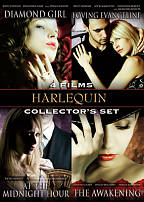
AT THE EARTH'S CORE
U,K, 1976, 86 minutes, Colour.
Peter Cushing, Doug Mc Clure, Carolyn Munroe.
Directed by Kevin Connor.
At the Earth’s Core is based on a story by Edgar Rice Burroughs, the author of the Tarzan stories.
The film was directed by Kevin Connor, an English director who has worked mainly in the United States. However, in the United Kingdom he made the compendium film From Beyond the Grave as well as Trial By Combat (A Choice of Arms). He also made a number of films in the vein of At the Earth’s Core including The Land That Time Forgot, 1975, The People That Time Forgot, 1977, and Warlords of Atlantis. He relied on Doug Mc Clure as the hero and on Peter Cushing as the professor.
This film has a giant boring device being used for an experiment in Wales. Because it is so powerful, it actually bores through the Earth more quickly than expected, finds a group of humans who are enslaved to Pterodactyls who help the explorers on their mission.
The film does not compare so well with other action adventures designed by effects expert Ray Harryhausen. Some of the effects look far too artificial in this film. However, it is a Boys’ Own adventure – best appreciated by a Boys’ Own audience.
1. For whom was this made? For what age audience? Science fiction interest, Boys Own Adventure interest? A successful example of comic strip Boys Own adventure science-fiction?
2. The 19th and 20th century backgrounds of Edgar Rice Burroughs, Jules Verne, H.G.Wells, the type of science fiction that they wrote, science fantasy? The background of 19th and 20th century technology, the possibilities of technology? The fantasy worlds which are explored by such technology? Reality and fantasy? The incorporation of traditional monsters, heroes, heroics? The larger-than-life presentation of such stories? The basic response to this kind of story?
3. Comment on the film's visual presentation of this kind of world: the unsubtle presentation, comic-strip characterization and piling on of situations? How important is this? Does the lack of subtlety matter?
4. The quality of presentation, the sets, the re-creation of the fantasy world of Pellucidar? The re-creation of the monsters and the variety of monsters, the actions that they perform, fights, sacrifices etc.? The use of appropriate music for audience response to these stories?
5. The historical opening, the plausibility of the situations, scientific investigations, the British professor and the American hero? The establishing of the 'Iron Mole'? The way that it looked, the work that it did? The backgrounds of 19th century fantasy adventure? Stock characters, the re-creation of the times?
6. The first drilling, the dangers, the anticipation of dangers and adventure? The technical presentation of the boring?
7. The character of Dr Perry and the satire on the absent-minded English professor? Peter Cushing's style? The very British tones of the character, the particular British details, the God-given mission to make civilization British? The contrast with David as the clean-cut American hero?
8. Response to the visual impression of Pellucidar, at the earth's core, the plausibility of the landscape, the pink colouring, the atmosphere, the vegetation, the initial encounters with the animals and their danger, prehistoric monsters and vegetation, the caves and their mystery? Audience interest in the fantasies of a prehistoric world contemporary with our own?
9. The Sagoth soldiers, their stage of evolution, their sounds, the world of slavery and their cruelty? The use of mesmerism, the Mahars and their hold over the soldiers? Conventional prehistoric monsters? Presuppositions about evolution? The details of their way of life, society, rule over the human beings?
10. The re-creation of the animals, the number of fights, contests, flames, destruction? The quality of these adventures?
11. The Mahars as symbols of evil, their visual presentation, their sinister nature and behaviour, their terrorizing the girls and destroying them? The visualizing of their threats, swooping, destruction? The parallel with ancient dynasties and human sacrifice? The reaction of the 19th century British, the American? Modern audience response and revulsion?
12. The human beings as slaves, the characters of Dia, Ra, Ghak, the Sly One, Jubal and the ugly villain? The portrait of society, Conventional heroes and heroines? The dangers they encounter? The people from Earth redeeming and saving these underground people?
13. Which were the most impressive danger sequences involving the audience, David and his heroics, the siege, the rescues?
14. The build-up to the climax, the peril for Dia, Ra and his leadership, the professor and his discoveries, David and his overcoming the caverns and their dangers?
15. How enjoyable is this kind of naive science?fiction on the realistic level, on the fantasy level? The original novel ended with David returning to the earth's core. Would that have been a more appropriate ending for the film?